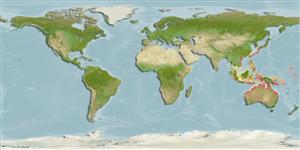Environment: milieu / climate zone / depth range / distribution range
Ecología
marino asociado a arrecife. Tropical; - 28°S
Indo-West Pacific: endemic to Australia.
Tamaño / Peso / Age
Maturity: Lm ? range ? - ? cm
Max length : 4.3 cm NG macho / no sexado; (Ref. 46892)
Short description
Claves de identificación | Morfología | Morfometría
Differences between this species and P. longispinis uncertain that this species is probably a synonym of latter.
Found in inshore reefs (Ref. 7300) of the continental shelf. Benthic (Ref. 75154).
Life cycle and mating behavior
Madurez | Reproducción | Puesta | Huevos | Fecundidad | Larva
Paxton, J.R., D.F. Hoese, G.R. Allen and J.E. Hanley, 1989. Pisces. Petromyzontidae to Carangidae. Zoological Catalogue of Australia, Vol. 7. Australian Government Publishing Service, Canberra, 665 p. (Ref. 7300)
IUCN Red List Status (Ref. 130435: Version 2024-1)
Threat to humans
Harmless
Human uses
Herramientas
Special reports
Download XML
Fuentes de Internet
Estimates based on models
Preferred temperature (Ref.
123201): 24.6 - 29.2, mean 28.2 °C (based on 1407 cells).
Phylogenetic diversity index (Ref.
82804): PD
50 = 0.5625 [Uniqueness, from 0.5 = low to 2.0 = high].
Bayesian length-weight: a=0.01000 (0.00244 - 0.04107), b=3.04 (2.81 - 3.27), in cm total length, based on all LWR estimates for this body shape (Ref.
93245).
Nivel trófico (Ref.
69278): 3.2 ±0.3 se; based on size and trophs of closest relatives
Resiliencia (Ref.
120179): Medio, población duplicada en un tiempo mínimo de 1.4-4.4 años (Preliminary K or Fecundity.).
Fishing Vulnerability (Ref.
59153): Low vulnerability (10 of 100).
Nutrients (Ref.
124155): Calcium = 310 [93, 834] mg/100g; Iron = 0.951 [0.354, 2.340] mg/100g; Protein = 16.4 [14.5, 18.4] %; Omega3 = 0.255 [0.076, 0.881] g/100g; Selenium = 13.3 [3.9, 46.0] μg/100g; VitaminA = 777 [123, 4,621] μg/100g; Zinc = 3.31 [1.77, 6.10] mg/100g (wet weight);
